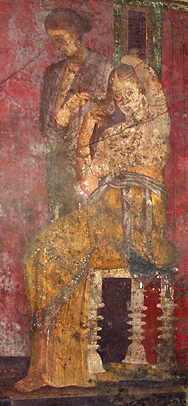 Preparation of the Bride
Preparation of the BrideFresco, Villa of the Mysteries
Pompeii, mid-1 century CE
 Preparation of the Bride
Preparation of the BrideTwo women are featured in this brief passage: one is a girl, not present and identified only by her generic roles as filia and prospective nupta; the other, an elite matrona, is the high-ranking priestess of Jupiter, the Flaminica Dialis, married to the Flamen Dialis (see Flamen), with whom she lived in the Flaminia (Gellius, Noctes Atticae X.15). The setting is early June, during the Vestalia (June 7-15), the annual festival in Rome to honor Vesta, the goddess of the state hearth. The scene is narrated by the poet, a father who, prompted by his desire for a son-in-law, deferentially consults the priestess of Jupiter --significantly not her husband-- about the proper times for his daughter to be married. While the text below expresses the warm affection of a paterfamilias for his only child, in it Ovid adds nothing to the little he reveals in his works about his actual daughter: in Tristia 1.3.19-20 he writes of his grief that she was unaware of his exile i n 8 BCE to Tomis, since she was in Libya at the time with her husband, the proconsul (Seneca identifies him as the senator Fidus Cornelius in De Constantia Sapientis 17.1); in Tristia 4.10.75-76 he mentions that his daughter made him a grandfather twice with a child from each of her two husbands. As for the docta puella Perilla in Tristia 3.7 (see also WRW, pp. 28-31), there is no scholarly agreement about Ovid's precise relationship to her or about who her mother was; it is possible that she, as the filia here, are poetic constructs to suit Augustus' program and policies of religious, moral, and social reform. This is the only surviving ancient source in which the Flaminica Dialis is not only present but speaks from her authority as sacerdos publica. Married as a virgin in the solemn patrician rite of confarreatio whose bond could not be dissolved except by death, she was a symbol of marital constancy. Although no images of her survive, requirements of her sacerdotium suggest that she was seen as emblematic of the fertility, matronal purity and prosperity of Rome: she wore her hair in the old-fashioned tutulus style (see video reconstruction), bound with purple vittae; Gellius pictures her cloaked in a dyed garment and wearing a branch of a fruit-bearing tree (perhaps a pomegranate wreath) in her head-dress (X.15.26-31); during public rituals she wore the flammeum, the enveloping flame-colored head veil worn by Roman brides (possible reconstruction) at their wedding (see the luteal coloring of the slipper, bed mattress, and flammeum folded beside the bride-to-be in the Aldobrandini wedding fresco). While the Flaminica Dialis shared some duties with her husband, who was required to resign his office at her death, she was a religious official in her own right: on the nundinae she sacrificed a ram to Jupiter in the regia (Macrobius, Saturnalia I.16.30) and carried a sacred knife called a secespita, which she used in sacrifices. During the city-wide festivals of the Argei (March and May) and the Vestalia (June), times that were nefas for weddings, she participated with the Vestals in the rituals of purification (see Ovid Fasti 2.19) conducted by them, by dressing in mourning clothes, not tending her hair and nails (see also Ovid Fasti 3.393-8), and abstaining from contact with her husband. The passage artfully presents two distinct voices, both the product of Ovid's ventriloquism: that of the deferential petitioning father of the bride and the solemn, assertive, sonorous response of the high priestess. The meter of the poem is elegiac couplet (see scansion of elegiac couplet). For more information on the topics in this essay, see Chiu (2016), DiLuzio (2016), Hallett (1984), Hemelrijk (1999), Hersch (2010), Ingleheart (2012), Littlewood (2006), Sebesta & Bonfante (2001) in the Bibliography; see also Matrimonium and Sacerdotes.
Est mihi (sitque, precor, nostris diuturnior annis)
220 filia, qua felix sospite semper ero.
hanc ego cum vellem genero dare, tempora taedis
apta requirebam, quaeque cavenda forent:
tum mihi post sacras monstratus Iunius Idus
utilis et nuptis, utilis esse viris,
225 primaque pars huius thalamis aliena reperta est;
nam mihi sic coniunx sancta Dialis ait:
"donec ab Iliaca placidus purgamina Vesta
detulerit flavis in mare Thybris aquis,
non mihi dentosa crinem depectere buxo,
230 non ungues ferro subsecuisse licet,
non tetigisse virum, quamvis Iovis ille sacerdos,
quamvis perpetua sit mihi lege datus.
tu quoque ne propera: melius tua filia nubet
Click on the underlined words for translation aids and commentary, which will appear in a small window. Click on the icon link
![]() to the right of the
poem for related images and information.
to the right of the
poem for related images and information.